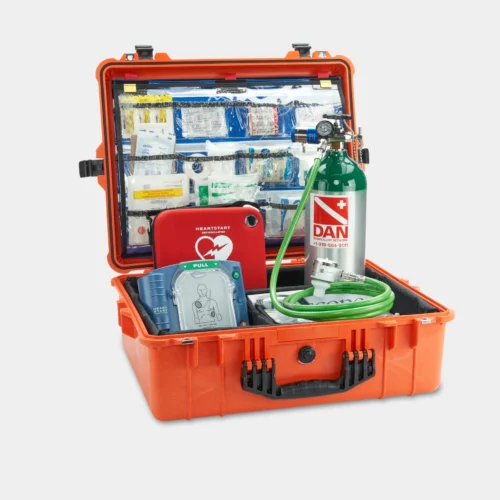First Aid for Diving Injuries: The Rescue Continues on the Surface
You’ve successfully performed an in-water rescue, bringing the victim safely to the boat or shore. It’s over, right? Not yet. For diving-related injuries, what you do in the first few minutes and hours after surfacing can profoundly impact a victim’s outcome.
Welcome to the medical side of the PADI Rescue Diver course. This Amadive article will dive deep into recognizing and managing the most serious injuries in scuba diving: Decompression Illness (DCI).

Demystifying Decompression Illness (DCI)
DCI is an umbrella term that covers two main types of pressure-related injuries.
1. Decompression Sickness (DCS)
- The Cause: Think of a soda bottle. When it’s sealed (under pressure), you see no bubbles. When you open it slowly, the gas escapes safely. But if you shake it and open it suddenly, bubbles erupt. Your body is similar. Under pressure at depth, nitrogen gas dissolves into your tissues. If you ascend too quickly, the nitrogen doesn’t have time to off-gas through your lungs, and it forms bubbles in your tissues and bloodstream, causing pain and damage.
- The Types:
- Type I: Less severe, typically affecting the skin (rashes, itching) and joints (pain, known as “the bends”).
- Type II: Very serious, affecting the central nervous system, heart, or lungs, causing symptoms like dizziness, paralysis, and difficulty breathing.
2. Arterial Gas Embolism (AGE)
- The Cause: This is a result of holding your breath on ascent (a lung-overexpansion injury). Trapped air in the lungs can rupture the alveoli, forcing gas bubbles directly into the arterial bloodstream. These bubbles can travel to the brain and block blood flow, causing stroke-like symptoms.
- The Onset: AGE typically has a very rapid onset, within minutes of surfacing, and is an extreme medical emergency.
Recognizing the Signs and Symptoms
The signs of DCI can be incredibly varied and sometimes vague. As a Rescue Diver, you must have a high index of suspicion.
The Single Most Important First Aid: Administering Emergency Oxygen

If you remember one thing from this article, let it be this: The primary first aid for any suspected case of DCI is to provide 100% oxygen.
- Why it works:
- Accelerates Nitrogen Washout: Breathing highly concentrated oxygen creates a large pressure gradient that “washes out” the nitrogen bubbles from the tissues and blood much more quickly.
- Re-oxygenates Starved Tissues: Gas bubbles can block blood flow. Providing more oxygen helps keep the affected tissues from suffering further damage.
Step-by-Step First Aid Protocol
- Activate your Emergency Assistance Plan (EAP) immediately. Call local Emergency Medical Services and/or DAN.
- Administer 100% oxygen using a non-rebreather mask.
- Have the victim lie down. If they feel nauseous, place them in the recovery position (on their side).
- Protect them from extreme heat or cold.
- Provide fluids (like water) if they are conscious and able to swallow.
- Gather information: Record the victim’s recent dive profiles (depths, times) to give to medical personnel.
- Continue providing oxygen until professional medical services take over.
Frequently Asked Questions (FAQ)
- Should I provide oxygen even if I’m not sure it’s DCI?
- Yes. For a breathing person, there is no downside to providing emergency oxygen, and the potential benefits are immense.
- How long after a dive can symptoms appear?
- AGE symptoms typically appear within 15 minutes. DCS can appear anywhere from a few minutes to 24 hours after a dive, but most commonly occurs within the first 1-3 hours.
Conclusion: A Vital Bridge to Care
Your DCI first aid knowledge is a vital bridge between the time of the accident and the time the victim receives professional medical care. By acting quickly and correctly, you can dramatically improve a fellow diver’s chances of a full recovery.
Important Disclaimer: This article is for informational purposes. These skills must be learned and practiced under the direct supervision of a certified PADI Instructor during a Rescue Diver course and an EFR/First Aid course.
➡️ To ensure you’re always prepared, learn what to do before the dive in How to Build an Emergency Assistance Plan (EAP)
